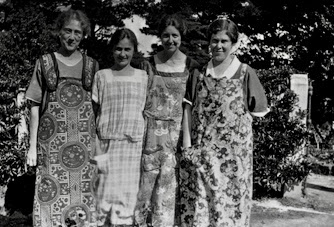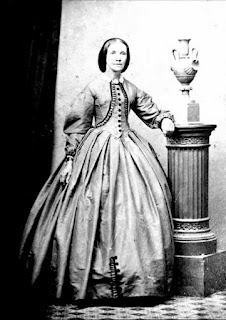14/52 Check this out: Juliet Seebohm 1859 - 1950
I said I wasn’t going to do any more 52 Ancestor blogs for a while and concentrate on transcribing letters. That didn’t last long! In the letters from my great aunt, Norah Godlee, I found something I had to check out!
In the summer of 1926 Norah was in England. She followed up her father’s cousins and one of them was Cousin Juliet.
Juliet née Seebohm was the granddaughter of Benjamin Seebohm who was born in Friedenstal, Germany, a member of a German Quaker community that was visited by Elizabeth Fry. This Benjamin migrated to England and married Esther Wheeler - another Quaker name of repute. Their second son was Juliet’s father. He was a barrister and although mentioned in the census as a banker, became famous as an economic historian. He was Juliet’s father and the great grandfather of Victoria (née Seebohm,) Glendinning. Juliet was Victoria's great aunt.
Juliet grew up in Hitchen, Herefordshire. They were well off. In the 1861 census when she was two, they had five servants: a nurse, a nursemaid, a cook, a housemaid and an under servant. Juliet was the only child at that stage but she had five more siblings. In 1871 there was a governess, a nurse, a nurserymaid, a cook, a house maid and under-servant, and a kitchen maid and the six children under 12. I’m like Norah, goggle eyed!
At age 31 she married Rickman John Godlee, called John because his father was Rickman Godlee - the brother of Norah’s grandfather. There was a class difference between the Australian Godlees and the English branches. Norah’s grandfather, who had migrated to Australia in 1838, had been shiftless and had been packed off by his older brothers to the Colonies to smarten him up. He suffered numerous insolvencies in South Australia. Juliet’s husband on the other hand, was son of a successful London Barrister, one of these older brothers.
John and Juliet did not have any children. Rickman John Godlee was a brain surgeon, and was knighted by Queen Victoria for his work. He is an interesting subject for a blog but my challenge is to write about the women so I have to pass him by. His sister was ‘Cousin Nina’ (aka Mary Jane Godlee) who has already appeared in this blog. Juliet's married life continued the life style she had grown up with - lots of servants. In 1901 she employed a cook, a parlour maid, a housemaid and a scullery maid. I wonder how she passed her time. She developed her art, painting and drawing. She was well read. She entertained. During WW1 she volunteered with the Red Cross between 1916 and 1919.
Juliet and John Godlee - (aka Sir and Lady Godlee )- lived in 19 Wimpole Street, Marylebone. When Norah’s brother, convalescing after Gallipoli, connected with them in 1915 they were living at Wimpole street but John says:
An exhibition of [Raemaekers] work is on view at the Fine Art Club but I have not had the opportunity of going yet. Cousin Juliet, who paints awfully well, is quite dippy over them. They are buying some, I believe, for the Wimpole Street home. They are down at the Coombe End Farm until Monday week I believe. I wish this place were handier to London as they wanted me very much to stay with them whilst doing my training.
In 1920 Juliet and John retired to Coombe End Farm.
When Norah visited Juliet at Coombe End Farm, she noticed a photo of her brother displayed in the house. He was killed in 1916, flying over France. After his death, letters were exchanged between Cousin Juliet and Norah’s sister, Margery and their mother, Charlotte, thanking Juliet for supporting their boy in that most awful of times. In July 1916 Margery, my grandmother, wrote to Juliet:
We know that over there, on the other side, you will be sharing in our sorrow and our pride, for you too have known and loved our boy. Mother feels that she can never thank you for all that you have done to make him happy while he was in England. He who had looked forward all his life to seeing England some day, found there a home and not only kind friends but loving kinsfolk, who took him into their home and gave him love at a time when his heart must have been fair sick for it. And this is what we have to thank you for! You will understand when we say that we never can sufficiently tell you our gratitude.
In April 1926, Norah spent the weekend at Coombe End Farm. She arrived on Saturday and Juliet met her at the station. Norah was quite nervous about meeting her:
It was strange, and yet not so, to be sitting there talking to Cousin Juliet after always hearing so much of her. She is not at all alarming, very much sweeter & more charming than I had thought she would be. Although she is very dignified & a ‘perfect lady’ & I hope I did not do anything very bad to disgrace the family!
Norah was not used to household servants. Although they had had a cook and a housemaid in Adelaide, she was surprised to find her clothes unpacked in her bedroom after they returned from a drive on Saturday afternoon, to be waited on at the table and to have a maid come in while she was dressing for dinner to ask if she needed a hand.
She admired the house, some of it dating to the 1600s. It had thirteen bedrooms. Norah was in the Summer room:
I am in my bedroom and it is the darlingest room imaginable. It is the summer room. It is blue & blue green, the sweetest colour, with white walls. This is inscribed on the door:
Summer redundant
Blueness abundant
where is the blot
Breath but one breath
Rose beauty above
And all that was death
Shows life, grows love
Grows love.
There was a farm attached to the house which is let out to ‘such a jolly girl’ who milks the cows and manages the property. She’ never wears a hat and has her hair off, of course.’
Cousin John died the year before Norah visited and Juliet was involved in collecting some of his writing together to publish a book. These short articles had appeared in the church paper, investigations of the history, natural and human, of the surrounding area. Juliet’s sketches also appear in the book. It is a most charming volume.
The next time Norah writes of visiting Juliet she is with two friends and they are passing by on their way home from a three week motoring holiday in the west country. Juliet invited them all for lunch. Norah says : ‘I was so glad I rang up as I felt a little doubtful whether I would do so or not. In fact, to be candid, I stood in the telephone box, (nasty hot old place,) for about 10 minutes, trying to make up my mind on the subject.’
Juliet continued to live at Coombe End until at least 1939. She died at age 90 in 1950 and presumably she is buried at the local church with her husband.
While I was transcribing Norah’s letters I wondered if the house were still there. We ‘googled’ it and found a fascinating article from 2008. The head line in the 30th of June, Evening Standard reads: A War in the Willows after squatters move in to Ratty’s house. It continues:
‘There hasn’t been a property battle like it since the weasels, stoats and ferrets took over Toad Hall. Squatters moved into a house which helped inspire Kenneth Grahame’s The Wind in the Willows. Coombe End Farmhouse is on the banks of he Thames and its boathouse is believed to have been the basis for the home of Ratty, one of the heroes of the classic book.’
Apparently Kenneth Graham lived close by to Coombe End. The house was left to the National Trust in the 1930s. It was leased to tenants but had been empty since 2006 and had fallen into disrepair. The two young squatters were highlighting the issue of youth homelessness and protesting the National Trust’s neglect of the property.
Further investigation reveals that the house has now been restored by the National Trust who list it as a Grade II building.
Coombe End Farmhouse graphically illustrates many of the changes in domestic lifestyles and architectural taste that have taken place over the last three centuries. The plan form with the 18th century reception rooms to the south and the main stairs, the 19th century service wing and back stairs to the north and the 1904 dining room wing designed by C.R.Ashbee in the Arts and Crafts style for which he is renowned are all important elements in the history of the house. Important specific features include the 17th century moulded beams, the 18th and 19th century period fireplaces, the period doors, leaded casements and lead pipehead.
I am glad to learn that Coombe End Farmhouse is protected. I hope that means I can visit it whenever I get to England again. Norah’s letters and the book Juliet published of John’s writings, including lyrical study of the water rats and the otters living around the boat shed, connect me to this place. I want to wander, like Norah and Juliet did, amongst the beech trees and the bluebells. I need to check it out.
'Messing about on boats'. A photo of some of the Godlees by the Thames at Coombe End.
References
English Census, 1861, 1871, 1881, 1891, 1901.
1939 England and Wales Register.
letter from Margery Godlee in The Dear Old Letters, the Letters of Charlotte Godlee, transcribed and edited by Sally O’Wheel, 2020.
Godlee John, The letters of John Godlee: the boy and the man, transcribed and edited by Sally O’Wheel, 2021.
Godlee, Norah, Letters - unpublished, in the possession of Sally O’Wheel.
"Godlee, Sir Rickman John (1849 - 1925)". Plarr's Lives of the Fellows. The Royal College of Surgeons of England.
Godlee, Rickman John, A Village by the River, 1927.
Gurney, Elizabeth, Elizabeth Fry’s Journeys on the Continent, 1840 -1841. From the diary of Elizabeth Gurney, The Bodley Head, London, 1931.
https://en.wikipedia.org/wiki/Frederic_Seebohm_(historian).
‘A War in the Willows after Squatters move in to Ratty’s House’, The Evening Standard, June 30. 2008.





Comments
Post a Comment